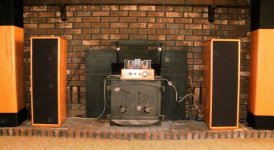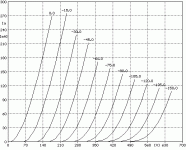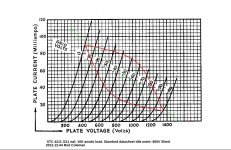I believe the only possible improvement would be if Michelangelo had carved the chassis out of white Italian marble. Well done!! I would need a bigger house if I had a set of you SET's.
I'll stick with my little 60w/channel sweep tube amps for now, they look small when compared to the transmission line speakers the elves
 finished for stocking stuffers. The head elf liked them enough he will build himself a set when the workshop warms up.
finished for stocking stuffers. The head elf liked them enough he will build himself a set when the workshop warms up.
Some day I would like to know the nuances of winding C-Core transformers or even where to find the components.I would appreciate it if you would post articles on your custom transformer process. I just rewound inductors with a heavier gauge wire to go from 200mA to 300mA. I also restacked a set of Hammond E-I transformer's laminations someone tried to mod with an .020" air gap to use for a SET. I took my time to flatten out each layer and stack. I did not want any mechanical noise... I have much yet to learn......
I'll stick with my little 60w/channel sweep tube amps for now, they look small when compared to the transmission line speakers the elves

Some day I would like to know the nuances of winding C-Core transformers or even where to find the components.I would appreciate it if you would post articles on your custom transformer process. I just rewound inductors with a heavier gauge wire to go from 200mA to 300mA. I also restacked a set of Hammond E-I transformer's laminations someone tried to mod with an .020" air gap to use for a SET. I took my time to flatten out each layer and stack. I did not want any mechanical noise... I have much yet to learn......
Attachments
Do those use passive crossover?Jadis Eurythmie loudspeakers.
As previously written, it is a Class A2 power amplifier based on 211 transmitter tube, with 300B driver tube and Emission Labs 20A input tube. So we have three active stages, all anode driven, no transistors (as previously questioned) anywhere of course. It is a zero feedback design (locally or globally) with nominal power output at 35 Watts per channel.
The output transformer has been designed to provide best sound and best measurements and it is the only part in this amp with balanced compromises. After all, it couldn't be otherwise. If you are forced to squeeze so much clean and undistorted power out of a 211 tube, you have to balance out some compromises that mother nature imposes. I could get slightly more power out of this monster (aca smaller tube load), I could get slighly better high freq response (aca fewer primary turns), I could get slightly better sound, but the balance of all those three are now reflected through the end result.
Specially for the driver tube, only 300B is able to drive 211 tube to its maximum potential as the output tube goes heavily in Class A2 mode of operation.
The level of the performance of this amplifier qualifies as extraordinary in all aspects, compared to any SET amp around. I know this first hand because I am both the designer of the amp and the coil winder of all iron pieces inside. IMHO it is the best demonstration of the pure undistorded SET sound when only music performance matters. There is no need to stay anymore on performance description because all visitors here are already exposed to good SET sound. Unfortunately, like in all good SET amps, the amplifier's cost is absolutely insane and out of this world. It might sound absolutely crazy to the inexperienced, but things cannot be done differently. Good SET sound, away from usual compromises and well known issues, is extremely expensive.
Please explain how you eliminated the normal levels of distortion your driver and output tubes would create without feedback. Did you use a distortion meter to confirm your claim of "undistorted" performance?
There are two things that I don't understand:
"no transistors anywhere" then later "DC heated through separate power supplies of course and current source devices"
"It is a zero feedback design (locally or globally)" then later "All tubes are self-biased"
It is a miracle amp, for lovers of miracles. Of course, the price should include insurance enough to cover an accidental death of the owner, his family members or guests, or pets.
Nice peace of jewelry. Dangerous, though...
I think it is fair to take account of the context of the word "undistorted". Peter has made clear that this is an open-loop amplifier with a named sequence of directly heated triodes.
When the Marconi-Osram PX25A was issued, the data sheet claimed that it was able to "supply a considerable undistorted volume", and the meaning of 'undistorted' is the same in both cases.
Naturally, it does not mean that you can connect a distortion meter to the output and claim that the amplifier is a failure because it shows 0,2% THD.
But what you can expect is that the whole sequence of DHTs are operating in their most linear regions, and fed from power supplies (HT and filament) that maintain the valve characteristics across full signal swing and frequency range - & adding minimal noise.
Peter has chosen the DHTs very well.
Start with the unusual EML20A, a high-mu triode designed for voltage-gain applications. Its performance can be assessed from measured curves:
http://www.emissionlabs.com/datasheets/20A-20B-curves.jpg
The anode-load is inductive, so designers can try their own near-horizontal load-lines on the curves, and see how good this DHT is.
Next comes the 300B, again with inductive load. Please compare the attached curves, taken by Audiomatica, and used with their kind permission:
Audiomatica Srl
The most impressive performance of all is from the end-stage, using the 211.
This is among the most linear devices available, with performance maintained over a swing of 1000V or more at the anode. We still have no semiconductor device to offer this kind of overall performance. To show something of how good it is, please see the attached curves for the STC version. An quasi-elliptical load is shown, to represent the reactive nature of the loudspeaker load. Data sheet values were used in plotting the load, maybe Peter has a better optimisation.
Substituting a triode-connected KT88 into the end-stage (even if operating voltages/currents were re-optimised) would result in gross distortion.
True, it would be interesting to see the spectrum of the output, and some assessment of intermodulation.
But using a THD meter to judge this amplifier would, as Lynn Olson memorably says, be like using a mass-spectrometer as the method to compare a Gourmet Meal versus School Dinners.
When the Marconi-Osram PX25A was issued, the data sheet claimed that it was able to "supply a considerable undistorted volume", and the meaning of 'undistorted' is the same in both cases.
Naturally, it does not mean that you can connect a distortion meter to the output and claim that the amplifier is a failure because it shows 0,2% THD.
But what you can expect is that the whole sequence of DHTs are operating in their most linear regions, and fed from power supplies (HT and filament) that maintain the valve characteristics across full signal swing and frequency range - & adding minimal noise.
Peter has chosen the DHTs very well.
Start with the unusual EML20A, a high-mu triode designed for voltage-gain applications. Its performance can be assessed from measured curves:
http://www.emissionlabs.com/datasheets/20A-20B-curves.jpg
The anode-load is inductive, so designers can try their own near-horizontal load-lines on the curves, and see how good this DHT is.
Next comes the 300B, again with inductive load. Please compare the attached curves, taken by Audiomatica, and used with their kind permission:
Audiomatica Srl
The most impressive performance of all is from the end-stage, using the 211.
This is among the most linear devices available, with performance maintained over a swing of 1000V or more at the anode. We still have no semiconductor device to offer this kind of overall performance. To show something of how good it is, please see the attached curves for the STC version. An quasi-elliptical load is shown, to represent the reactive nature of the loudspeaker load. Data sheet values were used in plotting the load, maybe Peter has a better optimisation.
Substituting a triode-connected KT88 into the end-stage (even if operating voltages/currents were re-optimised) would result in gross distortion.
True, it would be interesting to see the spectrum of the output, and some assessment of intermodulation.
But using a THD meter to judge this amplifier would, as Lynn Olson memorably says, be like using a mass-spectrometer as the method to compare a Gourmet Meal versus School Dinners.
Attachments
I would stick with solid state to heat the filaments as they would outperform tungars any day. MOSFETs can be very very useful also with those big bottles.
Hi Gluca.
Have you ever played around with tungar bulbs?
I am asking so because I have gained a lot of experience during the last 2 years. You're right when mentioning 'would', actually they don't! Unfortunately you have to wind two more iron pieces per supply (CLC filter is necessary to avoid start-up arcing), too much complexity but the result is mind-blowing. Try it and you will see...
Have a nice day.
I think that Rod has covered all the aspects I would like to focus on.
Finally I think that criticism depends on the way you're looking at something. Criticism may be constructive or ill-disposed. This is too easy to perceive from the writings. I think that this tremendous effort does not deserve from us to lower the level of this conversation here. With my writings I think that the experienced DIYer has understood some things regarding the design and performance.
However, if you have any hesitation regarding performance, distortion, freq response etc., keep in mind that you are always invited to come to Athens, Greece. I will happily organize an event for you to experience something that is extraordinarily expensive, that reflects an enormous amount of effort, pain and courage and plays music very well.
I promise that this will be an unforgettable experience for you!
Finally I think that criticism depends on the way you're looking at something. Criticism may be constructive or ill-disposed. This is too easy to perceive from the writings. I think that this tremendous effort does not deserve from us to lower the level of this conversation here. With my writings I think that the experienced DIYer has understood some things regarding the design and performance.
However, if you have any hesitation regarding performance, distortion, freq response etc., keep in mind that you are always invited to come to Athens, Greece. I will happily organize an event for you to experience something that is extraordinarily expensive, that reflects an enormous amount of effort, pain and courage and plays music very well.
I promise that this will be an unforgettable experience for you!
Oh! And I am with you... these amps really need to be listened as THD will not tell you all the story (and tipically it is lower than 'norma' tubes amps)
The data sheet for the 211 specifies "typical condition" 2nd harmonic distortion of 5% driving the plates at 1250V. And that is the only operating point detail the builder has stated for anything in the circuit.
All of the "exrordinary performance" claims revolve around the flat frequency response. Is that all we need?
I am very impressed. How did you get the knowledge to wind such nice transformers and chokes?
Theo
Hello Theo.
I have studied mechanical engineering and have deep knowledge and more than 15 years of experience in electromagnetic applications. I am a coil winder since several years ago (must be 5 or 6, don't remember well) and have the passion to built such machines.
The uniqueness lies not in the aesthetics and how good the iron pieces look but how well they are designed and how well and precisely they have been wound. If you do not know the theory behind electromagnetism, it is not possible to design audio transformers. There exist numerous parameters and you have to manage all of them. Remember, this amp has absolutely nothing in signal path except interstage and output transformers.
Thanks for your kind words.
Peter.
- Status
- This old topic is closed. If you want to reopen this topic, contact a moderator using the "Report Post" button.
- Home
- Amplifiers
- Tubes / Valves
- Most exotic SET power amplifier


